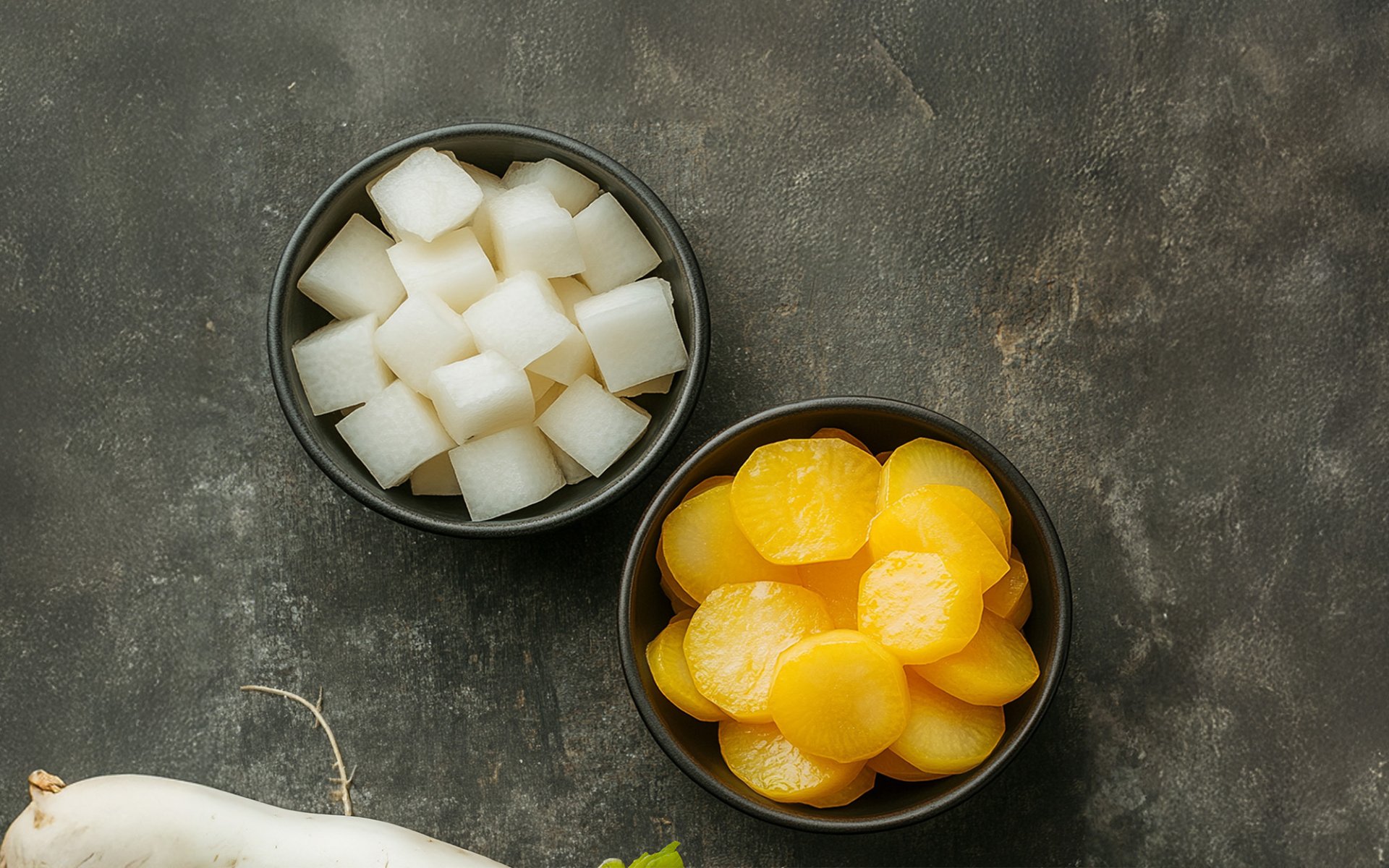Pickled Radishes

What is Pickled Radishes
Radishes, a root vegetable believed to have originated in Southeast Asia, have been cultivated since ancient times, dating back to 2,000 BCE. This versatile vegetable has been consumed in various forms, with pickling being a particularly popular preservation method used to extend its shelf life and retain its nutrients. This article delves into the fascinating history of pickled radishes in two prominent East Asian culinary traditions: Japan and Korea, exploring their significance, nutritional value, and unique appeal.
Takuan : A Legacy of Japanese Wisdom
In Japan, pickled radishes are known as Takuan (沢庵漬け), characterized by their thin, circular, yellow slices and a balanced sweet-salty flavor. The name Takuan is not arbitrary; it pays homage to Takuan Sōhō, a revered Zen monk of the 16th century, who is credited with inventing this particular recipe for pickled radishes.
The Legend of Its Creation and Evolution
Legend has it that Takuan Sōhō developed this recipe to improve the taste of radishes and prolong their preservation. The traditional process of making Takuan begins by sun-drying the radishes to reduce their water content and intensify their flavor. They are then pickled in a brine mixture of rice bran, salt, and sugarkey ingredients that impart flavor and aid in preservation. Over time, the Takuan recipe has evolved and diversified. Some modern variations may include vinegar for a tangier, sweet-sour taste, or even chili for a spicier kick. These adaptations reflect both culinary creativity and the changing preferences of consumers.
Takuan as a Cornerstone of Traditional Japanese Cuisine
In ancient times, Takuan was more than just a side dish; it was an essential component of the traditional Japanese meal known as Ichiju Sansai (一汁三菜), meaning one soup, three dishes. This simple yet balanced meal typically comprised miso soup and three accompanying side dishes, one of which was almost always a pickled vegetable like Takuan. The crisp texture and refreshing taste of Takuan perfectly complement other dishes, offering a pleasant contrast and cutting through richness in heavier meals. Furthermore, Takuan is known to aid digestion, a valued quality in Japanese culinary culture that emphasizes balance and well-being.
As time progressed, Takuan became a ubiquitous and beloved accompaniment in Japanese cuisine. It is commonly served with steamed rice, ramen, udon, or even incorporated as a primary filling in sushi rolls (makizushi). Its ability to enhance flavors and add an interesting textural element has made Takuan a cherished staple for people of all ages and social strata in Japan.
Danmuji and Chicken-mu: Korean Adaptations and Culinary Pairings
In Korea, pickled radishes were introduced during the Japanese occupation in the early 20th century. Unlike its Japanese counterpart, the pickled radish in Korea is called Danmuji (단무지). While similar in appearance to Japanese Takuan, the Korean recipe has been adapted to emphasize a sweeter and tangier flavor profile, aligning with the bolder and more diverse tastes of Korean cuisine.
Danmuji in Korean Daily Life
Danmuji has become an indispensable side dish in various Korean meals. It is often served with steamed rice, grilled meats, or as a crucial accompaniment to popular dishes like Jajangmyeon (Korean black bean noodles) and Tteokbokki (spicy stir-fried rice cakes). Its sweet-sour taste helps to cut through richness, and its crunchy texture provides a refreshing contrast, making Danmuji an essential component in balancing the flavors of a Korean meal. Moreover, Danmuji is versatile enough to be incorporated into other dishes, such as stir-fried with eggs, added to fried rice, rolled into Kimbap (seaweed rice rolls), or used in Korean-style salads, showcasing its adaptability in the kitchen.
Chicken-mu: The Perfect Companion for Korean Fried Chicken
Beyond Danmuji, another highly popular form of pickled radish in Korea is Chicken-mu (치킨무). Unlike Danmuji, Chicken-mu is characterized by its white, cube-shaped pieces, typically pickled predominantly in vinegar. What makes Chicken-mu widely known is its popular pairing with Korean Fried Chicken, a dish that has gained global popularity. The refreshing sour taste of Chicken-mu effectively cuts through the richness of the intensely flavored fried chicken, making it even more enjoyable to eat. It's a perfect match cherished by Koreans and enthusiasts of Korean fried chicken worldwide.
Nutritional Value of Pickled Radishes: Delicious and Healthy
Pickled radishes are not just a delicious side dish that enhances the culinary experience; they also offer significant nutritional benefits.
- Rich in Antioxidants: Radishes are high in antioxidants, which are compounds that help protect the body's cells from damage caused by free radicals. Regular consumption of antioxidant-rich foods can help reduce the risk of various chronic diseases, including cancer, heart disease, and high blood pressure.
- Aids in Digestion: Radishes are a good source of dietary fiber, which is crucial for a healthy digestive system. Fiber promotes regular bowel movements, reduces bloating and indigestion, and helps food move through the digestive tract more efficiently. Furthermore, the pickling process can introduce probiotics, beneficial bacteria that support gut health and further enhance digestive well-being.


